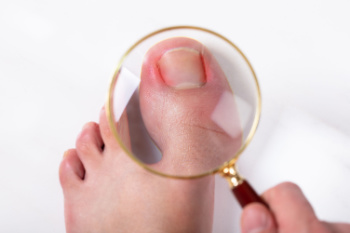
Ingrown toenails occur when the edges of the nail grow into the surrounding skin, often leading to pain, redness, swelling, and sometimes infection. This common condition typically affects the big toe and can result from improper nail trimming, wearing tight footwear, or injury. When an ingrown toenail becomes infected, it can cause increased pain and pus formation, making walking uncomfortable. To manage an infected ingrown toenail, it is important to keep the area clean and avoid tight shoes. Soaking the foot in warm, soapy water can help reduce inflammation and relieve discomfort. However, if symptoms persist or worsen, professional treatment is often necessary. A podiatrist can safely remove the ingrown portion of the nail and prescribe antibiotics if an infection is present. If you are struggling with an ingrown toenail, it is suggested you do not wait for it to worsen, but promptly schedule an appointment with a podiatrist for expert care and relief.
Ingrown toenails may initially present themselves as a minor discomfort, but they may progress into an infection in the skin without proper treatment. For more information about ingrown toenails, contact one of our podiatrists of Comprehensive Foot & Ankle Center. Our doctors can provide the care you need to keep you pain-free and on your feet.
Ingrown Toenails
Ingrown toenails are caused when the corner or side of a toenail grows into the soft flesh surrounding it. They often result in redness, swelling, pain, and in some cases, infection. This condition typically affects the big toe and may recur if it is not treated properly.
Causes
- Improper toenail trimming
- Genetics
- Improper shoe fitting
- Injury from pedicures or nail picking
- Abnormal gait
- Poor hygiene
You are more likely to develop an ingrown toenail if you are obese, have diabetes, arthritis, or have any fungal infection in your nails. Additionally, people who have foot or toe deformities are at a higher risk of developing an ingrown toenail.
Symptoms
Some symptoms of ingrown toenails are redness, swelling, and pain. In rare cases, there may be a yellowish drainage coming from the nail.
Treatment
Ignoring an ingrown toenail can have serious complications. Infections of the nail border can progress to a deeper soft-tissue infection, which can then turn into a bone infection. You should always speak with your podiatrist if you suspect you have an ingrown toenail, especially if you have diabetes or poor circulation.
If you have any questions, please feel free to contact our offices located in Lehigh Ave and Nazareth Hospital in Philadelphia, Collegeville Darby, and Langhorne, PA . We offer the newest diagnostic and treatment technologies for all your foot care needs.
